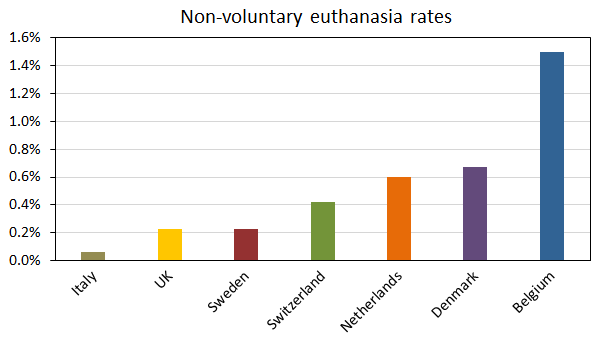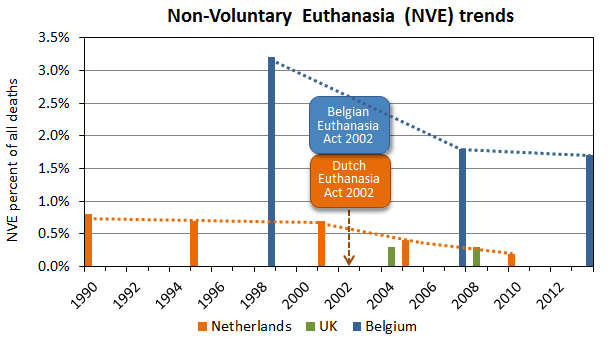The High Court of Ireland was fed bull
Back in 2013 the High Court of Ireland rejected a legal bid by multiple sclerosis sufferer Marie Fleming to achieve a lawfully-assisted peaceful death.
The Court naturally relied on expert testimony in reaching its judgement, yet its conclusions included a statement containing significant errors of fact.
The erroneous statement
In its judgement,1 the Court made the following statement:
“Above all, the fact that the number of LAWER (“legally assisted deaths without explicit request”) cases remains strikingly high in jurisdictions which have liberalised their law on assisted suicide (Switzerland, Netherlands and Belgium) — ranging from 0.4% to over 1% of all deaths in these jurisdictions according to the latest figures — without any obvious official response speaks for itself as to the risks involved.” [My emphases in bold]
In fact, the Court's judgement is wrong on not one, not two, but three significant matters. But that hasn't stopped opponents of assisted dying law reform from quoting the judgement as though it were factual and persuasive, when it isn't: relying on it because it was made by a High Court—the 'authority bias.'
Consequences
Here are just a few examples of the Court's statement being wielded by assisted dying opponents as though it were conclusive evidence against law reform:
- Hannah Graham and Dr Jeremy Pritchard's rebuttal of legislative reform in Tasmania, Australia.
- Family First’s submission opposing assisted dying law reform in New Zealand.
- Catholic lobbyist Paul Russell and Catholic NSW MP Greg Donnelly in submissions to the Victorian (Australia) Parliament inquiry into end-of-life choices.
- Catholic Professor Margaret Somerville in the New England Journal of Medicine,2 repeated by Alex Schadenberg of the Euthanasia Prevention Coalition as well as by Catholic-founded National Right To Life News; and Somerville again in the (Catholic) Newman Rambler.3
- John Keown in the (Catholic) Notre Dame Journal of Law, Ethics and Public Policy,4 also reproduced by Run With Life blogspot and Biblical Scholarship.
- Ryan Anderson of the conservative think-tank the DeVos Center for Religion and Civil Society, also reproduced by Alex Schadenberg.
- The Catholic Civil Rights League of Canada.
- The [Christian] Conservative Woman.
These examples illustrate the frequency of quoting the misinformation and how it feeds into and wrongly shapes public policy formation.
Three strikes
So what are the three counts on which the Court's judgement was seriously wrong?
Strike 1: Wrong concept
First, let’s get the concepts right. LAWER is not “legally assisted deaths without explicit request.”
Such nomenclature is an oxymoron. To ‘assist’ is to accommodate, serve or help someone accomplish something. But if there has been no request then one cannot be helping. You can’t ‘assist’ a little old lady across the road if she has expressed no interest in going there: you’d be forcing her across the road. Equally, you can’t ‘assist’ a death if there’s no proper ‘request.’
LAWER in fact stands for “Life-ending Acts Without Explicit Request” (of a competent patient).5 And with the exception of the possible ‘lawfulness’ of the doctrine of double effect, such acts are illegal.
Further, if such acts were legal as the Court’s statement posits, then there would be no need for an “obvious official response” as the Court then concludes. The statement lacks fundamental coherence.
Strike 2: Not ‘strikingly high’
The Court's judgement states unequivocally that LAWER (otherwise known as Non-Voluntary Euthanasia or NVE) rates in Switzerland, the Netherlands and Belgium are ‘strikingly high’, though no comparative yardstick is recorded in the judgement by which one might draw or justify that subjective judgement. Similar 'strikingly high' statements also appear in sections 102 and 104 of the judgement.
There is in fact a scientific study, published in The Lancet in 2003, that provides sound empirical evidence that could have properly informed the Court (Figure 1).6
As revealed by this study, the NVE rates in Switzerland and the Netherlands were in fact lower than in Denmark, a country which has never had an assisted dying law.
The only country which did appear to have an NVE rate notably higher than the others was Belgium. The research study collected the data for analysis between June 2001 and February 2002. However, Belgium’s Euthanasia Act was not passed by its Parliament until 28th May 2002, well after data collection was complete. Thus, even in describing Belgium’s NVE rate as ‘strikingly high’ compared to a number of other European countries, it cannot be attributed to an assisted dying law because none existed at the time.
In fact, the NVE rate in Belgium had been found to be high back in 1998,7 well before the Bill for the country's Euthanasia Act was even tabled in Parliament.
Further, if assisted dying laws had such effects, it might be expected that the NVE rate would increase the longer that assisted dying laws were in place. In that case the NVE rates in Switzerland (statute since 1942) and the Netherlands (regulation since the early 1980s) would have NVE rates much higher than Belgium’s (statute since 2002). But the exact opposite is true.
Indeed, Rietjens and colleagues8 further concluded in their review of NVE in the Netherlands, Belgium, Denmark and Switzerland that “the use of drugs with the intention to hasten death without an explicit request of the patient is part of medical end-of-life practice in the studied countries, regardless of their legal framework, and it occurs in similar fashion.” The study, published in 2007, would also have been important evidence before the Court.
Strike 3: Not ‘remaining’ high
The Court's judgement states unequivocally that the LAWER (NVE) rate of the three countries ‘remains’ strikingly high. No specific evidence was supplied in the judgement to support this statement. Indeed, the judgement notes:
- In section 28 that Dutch NVE had been “consistently declining.”
- In section 91 that “the number of LAWER deaths has significantly declined in both [Dutch and Belgian] jurisdictions.”
- In section 94 that “the trend in [Dutch] LAWER cases are declining in numbers (from 1,000 in 1990 to 550 in 2005)” and that in Belgium “the number of LAWER cases has declined since legalisation of assisted death.”
- In section 101 that the NVE rates of both the Netherlands and Belgium had dropped.
Despite this clear and repeated evidence, the Court summarises in section 96 that the evidence cannot be “regarded as encouraging or satisfactory.”
But what does empirical research tell us about the NVE trends? In both the Netherlands and Belgium, since assisted dying was enshrined in statute and became effective in 2002, the rate of NVE has decreased significantly (Figure 2).7,9-11 In fact, the rate in the Netherlands is now similar to that in the UK, a country which has never had an assisted dying law and which provides the world’s gold standard in palliative care practice.
These are critical yardsticks by which to judge practice in jurisdictions that have assisted dying laws with jurisdictions that don't. The UK study was published in 2009 and was readily available prior to the High Court’s hearings, yet appears not to have been presented in evidence.
The final (2010) Dutch NVE statistic in Figure 2 may or may not have been available to the Court: it was published in 2012 around the time the Court was taking evidence. The final (2013) Belgian statistic would not have been available to the Court as it was published in 2015.
Conclusion
While the High Court worked diligently within the scope of evidence brought before it:
- The Court’s definition of LAWER is incorrect and incoherent;
- Its statement that the NVE rates of the Netherlands and Switzerland are ‘strikingly high’ are evidentially wrong when compared with other countries without assisted dying laws;
- Its implication that the higher NVE rate in Belgium was caused by assisted dying law reform is evidentially wrong; and
- Its statement that the rates remain high is evidentially wrong.
The High Court's judgement does not provide defensible evidence or argument against assisted dying law reform.
Many lobbyists have repeated these incorrect statements, significantly misleading media, policy makers and legislators.
Now that the facts are readily available it’s appropriate to avoid repeating evidentially wrong statements, regardless of the apparent 'authority' of their source.
Summary of facts
- LAWER stands for "Life-ending Acts Without Explicit Request". Its practice is similar in countries with and without assisted dying laws.
- The NVE rates in the Netherlands and Switzerland are lower than the rate in Denmark, a country which has never had an assisted dying law.
- The NVE rate in Belgium appears higher, but was so long before assisted dying law reform and so cannot have been caused by such a law.
- The NVE rates of the Netherlands and Belgium have both decreased significantly since their assisted dying statutes came into effect in 2002.
References
- High Court of Ireland 2013, Fleming v Ireland & Ors - Determination, [2013] IEHC 2, Dublin.
- Boudreau, JD, Somerville, MA & Biller-Andorno, N 2013, 'Physician-assisted suicide: should not be permitted/should be permitted', New England Journal of Medicine, 368(15), pp. 1450-1452.
- Somerville, M 2016, 'Killing as kindness: The problem of dealing with suffering and death in a secular society', The Newman Rambler, 12(1), pp. 1-26.
- Keown, J 2014, 'A right to voluntary euthanasia? Confusion in Canada in Carter', Notre Dame Journal of Law, Ethics & Public Policy, 28(1), pp. 1-45.
- Pijnenborg, L, van der Maas, PJ, van Delden, JJM & Looman, CW 1993, 'Life-terminating acts without explicit request of patient', Lancet, 341(8854), pp. 1196-1199.
- van der Heide, A, Deliens, L, Faisst, K, Nilstun, T, Norup, M, Paci, E, van der Wal, G & van der Maas, PJ 2003, 'End-of-life decision-making in six European countries: descriptive study', The Lancet, 362(9381), pp. 345-350.
- Bilsen, J, Cohen, J, Chambaere, K, Pousset, G, Onwuteaka-Philipsen, BD, Mortier, F & Deliens, L 2009, 'Medical end-of-life practices under the euthanasia law in Belgium', New England Journal of Medicine, 361(11), pp. 1119-1121.
- Rietjens, JA, Bilsen, J, Fischer, S, Van Der Heide, A, Van Der Maas, PJ, Miccinessi, G, Norup, M, Onwuteaka-Philipsen, BD, Vrakking, AM & Van Der Wal, G 2007, 'Using drugs to end life without an explicit request of the patient', Death Studies, 31(3), Mar, pp. 205-21.
- Seale, C 2009, 'End-of-life decisions in the UK involving medical practitioners', Palliat Med, 23(3), pp. 198-204.
- Onwuteaka-Philipsen, BD, Brinkman-Stoppelenburg, A, Penning, C, de Jong-Krul, GJF, van Delden, JJM & van der Heide, A 2012, 'Trends in end-of-life practices before and after the enactment of the euthanasia law in the Netherlands from 1990 to 2010: a repeated cross-sectional survey', The Lancet, 380(9845), pp. 908-915.
- Chambaere, K, Vander Stichele, R, Mortier, F, Cohen, J & Deliens, L 2015, 'Recent trends in euthanasia and other end-of-life practices in Belgium', N Engl J Med, 372(12), pp. 1179-1181.


 Figure 1: The non-voluntary euthanasia (NVE) rates of seven European countries in late 2001/early 2002
Figure 1: The non-voluntary euthanasia (NVE) rates of seven European countries in late 2001/early 2002 Figure 2: Empirical trends in NVE rates before and after legalisation of assisted dying
Figure 2: Empirical trends in NVE rates before and after legalisation of assisted dying